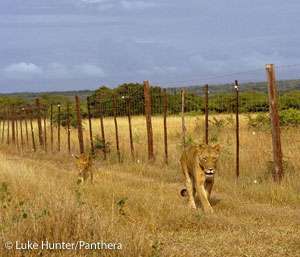New report confirms almost half of Africa's lions facing extinction

A new report published today concludes that nearly half of Africa's wild lion populations may decline to near extinction over the next 20-40 years without urgent conservation measures. The plight of many lion populations is so bleak, the report concludes that fencing them in - and fencing humans out - may be their only hope for survival.
Led by the University of Minnesota's Professor Craig Packer and co-authored by a large team of lion biologists, including Panthera's President, Dr. Luke Hunter, and Lion Program Director, Dr. Guy Balme, the report, entitled Conserving large carnivores: dollars and fence, was published today in the scientific journal Ecology Letters.
"It is clear that fences work and unfenced populations are extremely expensive to maintain," said Craig Packer, who also sits on Panthera's Cat Advisory Council. Using field data from 11 African countries, the Ecology Letters study examines the cost of managing fenced and unfenced habitats, and compares lion population densities and trends in both. The report shows that conservation costs are lower, and lion population sizes and densities are greater, in reserves secured by wildlife-proof fences, compared to unfenced ecosystems. Lions in unfenced reserves were subject to a higher degree of threats from human communities, including retaliatory killing by herders, habitat loss and fragmentation, and overhunting of lion prey.
Panthera's Dr. Luke Hunter explained, "These findings highlight the severity of the lion conservation crisis today and the limited choices we have to ensure a future for the species. No one wants to resort to putting any more fences around Africa's marvelous wild areas, but without massive and immediate increases in the commitment to lion conservation, we may have little choice."
Whether fencing or some alternative physical boundary such as intensely managed buffer zones, it is clear that separating lion and human populations will be essential for the species' survival. Along with maintaining physical boundaries, conflict mitigation initiatives such as those carried out through Panthera's Project Leonardo and the Lion Guardians program, are required to reduce the killing of lions where humans and lions share the landscape.
Panthera's Dr. Guy Balme stated, "We have shown that it is possible to keep both humans and lions in African landscapes by reducing lion-human conflict, but it requires extensive resources. As the numbers of people and their livestock continue to grow in Africa, it is essential to scale up these programs to avert losing many lion populations."
Today, it is estimated that fewer than 30,000 lions remain in Africa in just 25% of the species' original natural habitat.
Journal information: Ecology Letters
Provided by Panthera


















